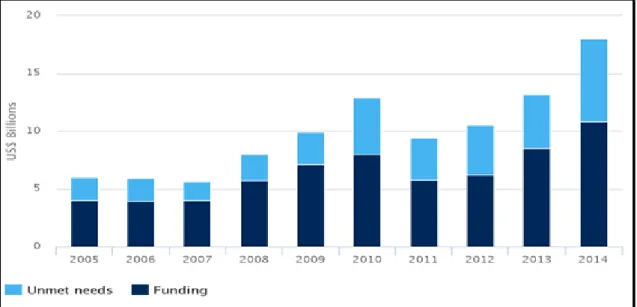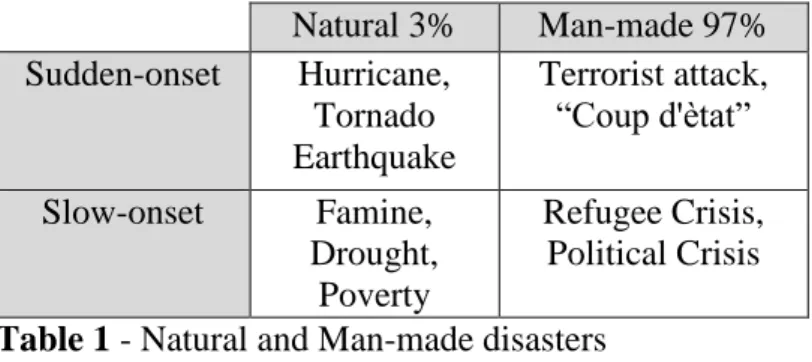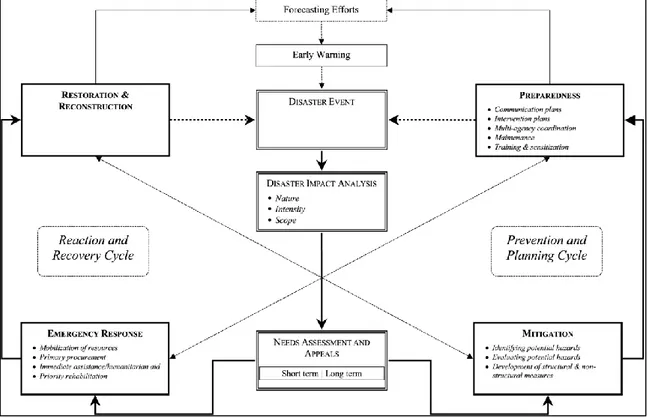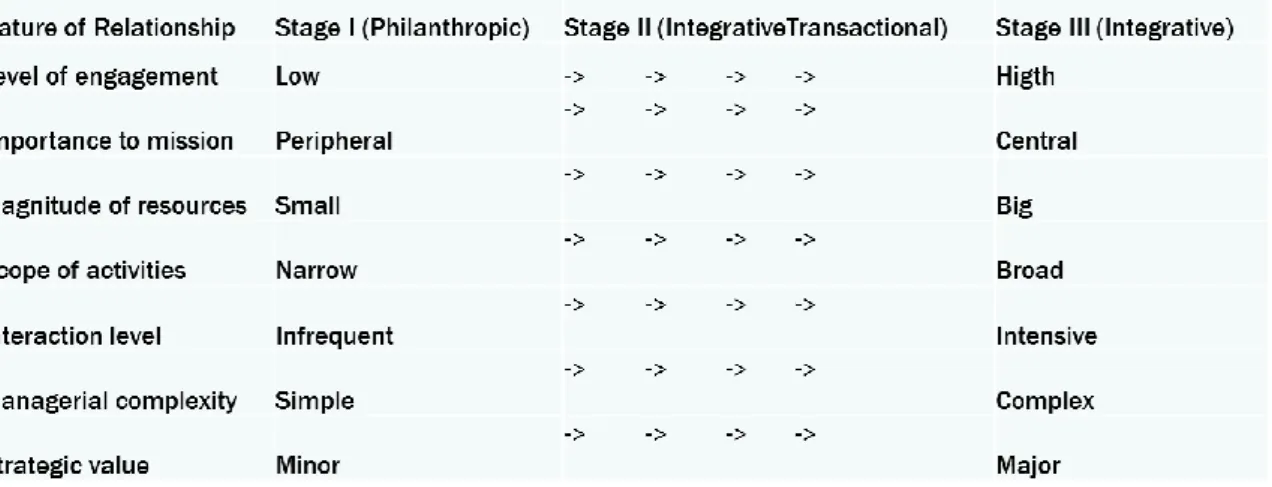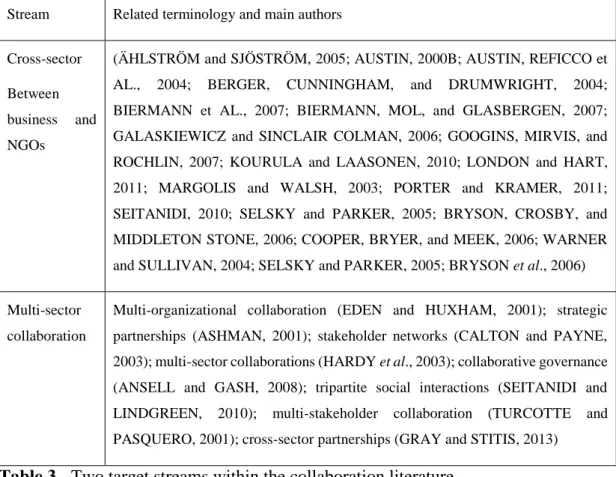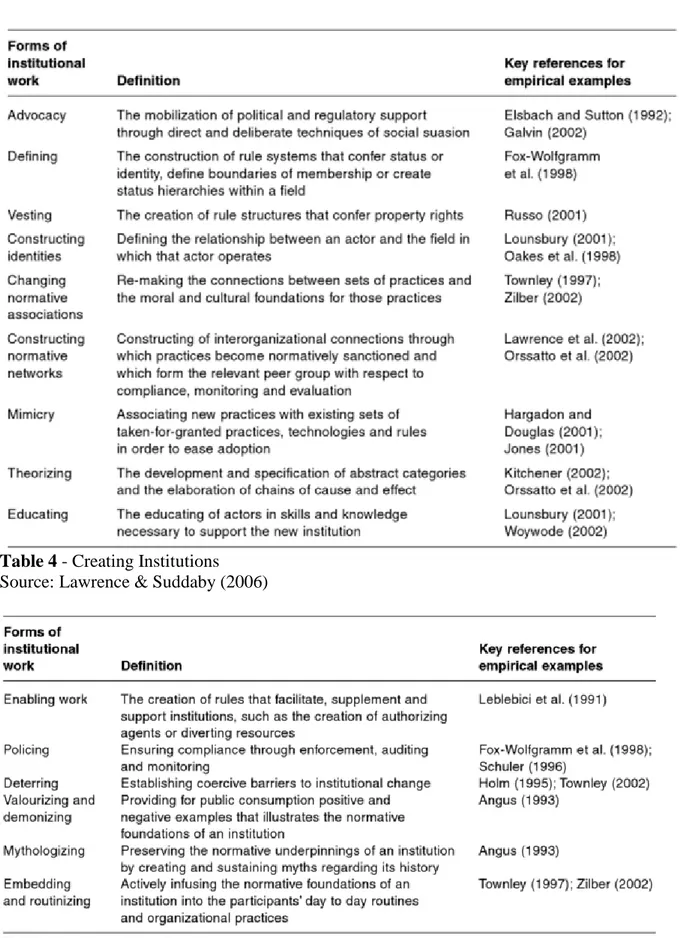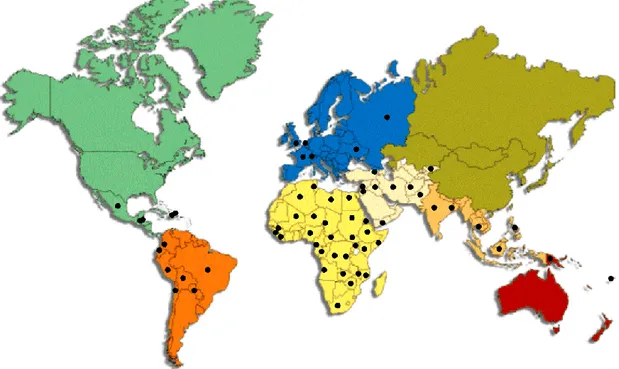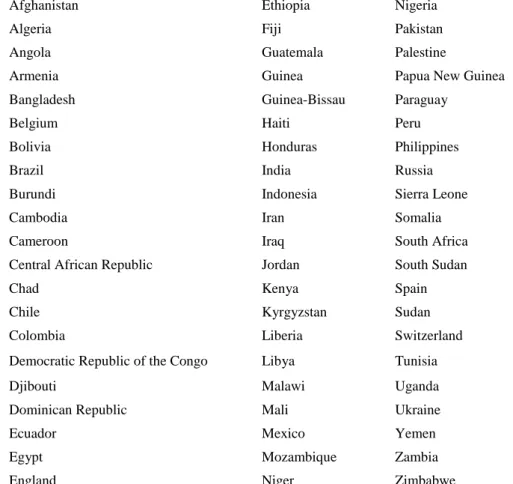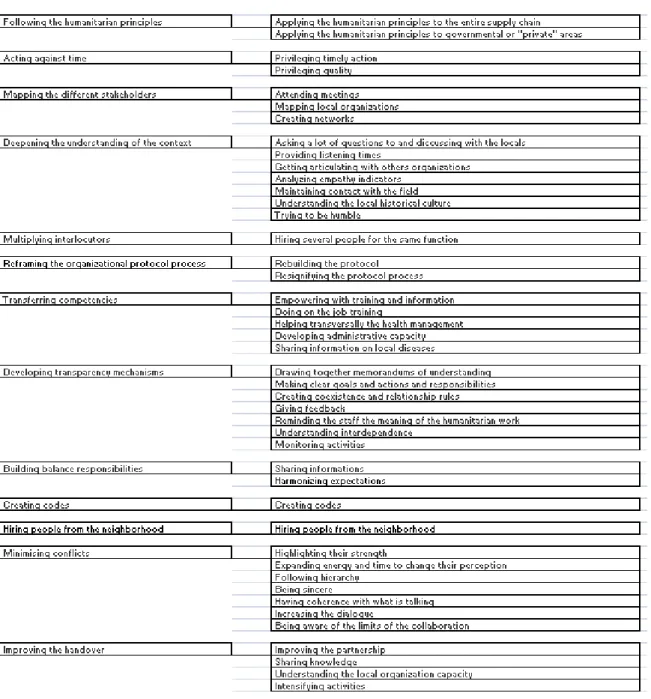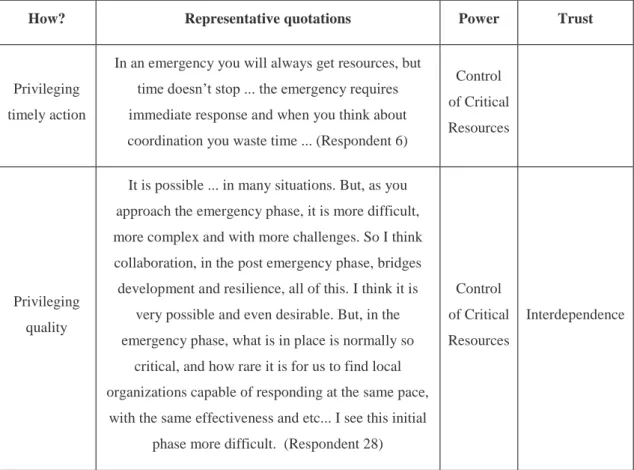FUNDAÇÃO GETULIO VARGAS
ESCOLA DE ADMINISTRAÇÃO DE EMPRESAS DE SÃO PAULO
RENATA DE OLIVEIRA SILVA
Building Collaboration in Humanitarian Operations:
The Role of Institutional Work
SÃO PAULO 2016
RENATA DE OLIVEIRA SILVA
Building Collaboration in Humanitarian Operations:
The Role of Institutional Work
Tese apresentada à Escola de Administração de Empresas de São Paulo da Fundação Getulio Vargas, como parte dos requisitos para obtenção do título de Doutor em Administração de Empresas.
Campo de conhecimento: Gestão de Operações e Sustentabilidade
Orientadora: Prof. Marlei Pozzebon
SÃO PAULO 2016
Silva, Renata de Oliveira.
Building collaboration in humanitarian operations : the role of institutional work / Renata de Oliveira Silva. - 2016. 136 f.
Orientador: Marlei Pozzebon
Tese (doutorado) - Escola de Administração de Empresas de São Paulo.
1. Assistência humanitária. 2. Socorro internacional. 3. Calamidades públicas - Socorro. 4. Organizações não-governamental. I. Marlei Pozzebon. II. Tese (doutorado) - Escola de Administração de Empresas de São Paulo. III. Título.
RENATA DE OLIVEIRA SILVA
Building Collaboration in Humanitarian Operations:
The Role of Institutional Work
Tese apresentada à Escola de Administração de Empresas de São Paulo da Fundação Getulio Vargas, como parte dos requisitos para obtenção do título de Doutor em Administração de Empresas.
Campo de conhecimento: Gestão de Operações e Sustentabilidade
Data de aprovação: 14/12/2016
Banca Examinadora:
___________________________________ Prof. Marlei Pozzebon (Orientadora) HEC Montréal – FGV/EAESP
___________________________________ Prof. Sonia Tello-Rozas
Université du Québec à Montréal
___________________________________ Prof. Armindo dos Santos de Sousa Teodósio PUC Minas
________________________________ Prof. Mario Aquino Alves
FGV/EAESP
________________________________ Prof. Fernando do Amaral Nogueira FGV/EAESP
To all the people who live in humanitarian needs and to the humanitarian workers
AGRADECIMENTOS
A construção de uma tese é um caminho solitário, que você não viaja sozinha. Neste processo, muitas pessoas contribuíram para a conclusão desta missão. Estou muito grata por ter concluído esta "viagem" com pessoas tão maravilhosas.
Agradecimentos especiais à minha orientadora, Prof. Marlei Pozzebon, pela oportunidade, confiança, gentileza, paciência, generosidade e dedicação no meu processo de aprendizagem. Agradeço que tenha compartilhado comigo seus conhecimentos e reflexões, permitindo alcançar a maturidade e a confiança no desenvolvimento do meu trabalho. Como uma grande líder, você me ajudou a crescer profissionalmente e pessoalmente, sempre me empurrando para o sucesso, Obrigada, Marlei! Você é um exemplo inspirador de mulher, pesquisadora e professora!
Quero agradecer a todos os professores da EAESP / FGV por compartilhar comigo uma nova maneira de ver o mundo: José Carlos Barbieri, Mario Aquino Alves, Ana Maria Malik, Renato Orsato, Barbara B. Flynn, Quinetta Roberson, Maria José Tonelli, Abraham Laredo Sicsú, Maria Ester de Freitas e muitos outros que contribuíram para aumentar e estimular meu amor pela pesquisa. Não posso deixar de agradecer ao orientador do meu mestrado, o professor Álvaro Escrivão Junior, que me encorajou e sempre acreditou no meu potencial, obrigado, professor! Agradeço também aos professores presentes na defesa final, Marlei Pozzebon, Mario Aquino Alves, Fernando do Amaral Nogueira, Armindo dos Santos de Sousa Teodósio e Sonia Tello-Rozas. Eu também quero agradecer a minha família. Eu amo cada um de vocês com todo meu coração. Agradecimentos especiais à minha mãe, Sílvia Regina; Meu pai Laerte; Meu irmão Alexandre e minha irmã Cáritas. E também minha sobrinha Ana Clara e meu sobrinho Pietro. Obrigado também aos amados (cães) Zeus, Luna, Marronzinha e Amarelinha, eles estavam sempre ao meu lado durante o processo de tese. Vocês são incríveis!
Não pude esquecer de agradecer aos meus amigos, Henrique Heidtmann Neto, Sergio Barros Filho, Marina Priolli, Hélio Arthur Irigaray, Patricia Mendonça, Patricia Ryan e Norberto Duarte. Obrigado por me incentivar sempre com doses de entusiasmo e carinho. Agradecimentos especiais a Marcos Raggiotto Golovattei, Gustavo Mauro, Patricia Ryan, Leila Dall Acqua, Jalba Miniussi e Enrico Cietta. Vocês são o suporte que todos os estudantes de doutorado precisam.
Obrigado Ana Paula Fleury, Maria Grazia Gorla Justa, Celso Malachias, Marcelo Sá, Genésio Vasconcelos, Artur Sartori, Dafne Oliveira, Carol Zanette, Julia de Carvalho e Luciana Iwashita e a todos os meus colegas no mestrado e doutorado, por estarem ao meu lado dando apoio, reflexão, incentivo, conversa e carinho, vocês são muito especiais. Eu quero estender este agradecimento aos meus amigos humanitários Claude Ngabu, Luiz Otávio Guimarães, Felipe Buzanovsky, Roufai Sani, Rodrigue Magloire, Mônica Guarnieri, Carla Kamitsuji, Julia Chagas Schimitd e Sarah Mbuyamba. E também para a família MSF! Vocês são ótimos!
Um agradecimento muito especial ao meu namorado Shane Anderson por todo o apoio durante todo o processo desta tese, além disso, obrigado pela revisão em inglês. Eu te amo!
Gostaria de agradecer à Escola de Administração de Empresas de São Paulo da Fundação Getulio Vargas - EAESP / FGV à oportunidade, instalações, infra-estruturas e também pela concessão de bolsa de estudos para o desenvolvimento deste projeto de pesquisa. Finalmente, agradeço a todas as pessoas que, direta ou indiretamente, contribuíram para o meu sucesso e conclusão desta importante fase da minha vida.
ACKNOWLEDGMENTS
The construction of a dissertation is a lonely road, which you do not travel alone though. In this process, many people have contributed to the conclusion of this mission. I am very grateful to have completed this “trip” with such wonderful people.
Special thanks to my advisor, Prof. Marlei Pozzebon, for the opportunity, trust, kindness, patience, generosity and dedication in my learning process. I am grateful that you have shared with me your knowledge and reflections, allowing me to reach maturity and confidence in the development of my work. As a great leader, you have helped me grow professionally and personally, always pushing me over the edge, Thank you, Marlei! You are an inspirational example of woman, researcher and professor!
I want to thank all professors from EAESP/FGV for sharing with me a new way of seeing the world: José Carlos Barbieri, Mario Aquino Alves, Ana Maria Malik, Renato Orsato, Barbara B. Flynn, Quinetta Roberson, Maria José Tonelli, Abraham Laredo Sicsú, Maria Ester de Freitas, and many others who contributed to increase and stimulate my love for research. I could not fail to thank my master’s advisor, Professor Álvaro Escrivão Junior, who encouraged me and always believed in my potential, Thank you, Professor! I also thank the professors present in the final defense, Marlei Pozzebon, Mario Aquino Alves, Fernando do Amaral Nogueira, Armindo dos Santos de Sousa Teodósio and Sonia Tello-Rozas.
I also want to thank my family. I love every one of you with all my heart. Special thanks to my mother, Sílvia Regina; my father, Laerte; my brother, Alexandre and my sister Cáritas. And also my niece Ana Clara and my nephew Pietro. Thank you also to the loved ones (dogs) Zeus, Luna, Marronzinha and Amarelinha, they were always by my side during the dissertation process. You guys are amazing!
I could not forget to thank my friends, Henrique Heidtmann Neto, Sergio Barros Filho, Marina Priolli, Hélio Arthur Irigaray, Patricia Mendonça, Patricia Ryan, and Norberto Duarte. Thank you for always encouraging me with doses of enthusiasm and affection. Special thanks to Marcos Raggiotto Golovattei, Gustavo Mauro, Patricia Ryan, Leila Dall Acqua, Jalba Miniussi and Enrico Cietta. You are the support that every doctoral student needs.
Thanks Ana Paula Fleury, Maria Grazia Gorla Justa, Celso Malachias, Marcelo Sá, Genésio Vasconcelos, Artur Sartori, Dafne Oliveira, Carol Zanette, Julia de Carvalho and Luciana Iwashita and to all my colleagues in the master’s and Ph.D. program that have ever been willing to help me in this process for all the support, reflection, encouragement, conversation, and affection, you are very special. I want to extend this thanks to my humanitarian friends Claude Ngabu, Luiz Otávio Guimarães, Felipe Buzanovsky, Roufai Sani, Rodrigue Magloire, Mônica Guarnieri, Carla Kamitsuji, Julia Chagas Schimitd and Sarah Mbuyamba. And also to MSF family! You guys are great!
A very special thank you to my boyfriend Shane Anderson for all the support during the whole process of this dissertation, in addition thank you for the English revision. I love you!
I’d like to thanks to Escola de Administração de Empresas de São Paulo da Fundação Getulio Vargas – EAESP/FGV to the opportunity, facilities, infrastructures, and also the scholarships to complete this project.
Finally, I thank all the people who directly or indirectly contributed to my success and conclusion of this important phase of my life.
ABSTRACT
This study aims to show the value of adopting institutional work as a theoretical lens to better understand the process of collaboration building in humanitarian operations. Studying the institutional work engaged by humanitarian operations and oriented toward collaboration between International Humanitarian Non-Government Organization and local organizations can shed light on the strategies and practices that have a potential to improve collaborations in complex and risky contexts. In this sense, the objective of this research is to answer the following question: How institutional work might contribute to improve our understanding about collaboration between IHNGOs and local organizations in humanitarian operations? To explore this issue, I invited a number of participants to share their experience, difficulties and ideas on how collaboration emerges between IHNGO and local organizations. I conducted 30 in-depth interviews with humanitarian workers from the biggest and most influence international humanitarian organizations, people with great experience that participated in the most challenging humanitarian operations in the last 10 years. The main contributions of this work is to provide a repertory of humanitarian institutional works and to highlight the ways in which power and trust – two conceptual elements suggested by the literature review – are mobilized by social actors to engage in collaboration in humanitarian operations.
Keywords
Humanitarian Operations, Humanitarian Workers, Disasters, Collaboration Social-driven, Multi-Sector Collaboration, Institutional Work, Power, Trust.
RESUMO
Esta tese objetivou mostrar o valor de adotar o trabalho institucional como uma lente teórica para melhor compreender o processo de construção de colaboração em operações humanitárias. Estudar o trabalho institucional envolvido por operações humanitárias e orientadas para a colaboração entre organizações humanitárias não governamentais internacionais e organizações locais pode esclarecer as estratégias e práticas que podem potencializar colaborações em contextos complexos e arriscados. Nesse sentido, o objetivo desta pesquisa é responder a seguinte questão: como o trabalho institucional pode contribuir para melhorar nosso entendimento sobre a colaboração entre as IHNGOs e as organizações locais em operações humanitárias? Para explorar esta questão, convidei vários participantes para compartilhar suas experiências, dificuldades e ideias sobre como a colaboração surge entre a IHNGO e as organizações locais. Realizei 30 entrevistas em profundidade com trabalhadores humanitários das maiores e mais influentes organizações humanitárias internacionais, pessoas com grande experiência que participaram das operações humanitárias mais desafiadoras nos últimos 10 anos. As principais contribuições deste trabalho são fornecer um repertório de trabalhos institucionais humanitários e destacar as formas em que o poder e a confiança - dois elementos conceituais sugeridos pela revisão da literatura - são mobilizados por atores sociais para se envolverem em colaboração em operações humanitárias.
Palavras-chaves
Operações Humanitárias, Trabalhadores Humanitários, Desastres, Colaboração Social, Colaboração Multi-Setorial, Trabalho Institucional, Poder, Confiança.
ILLUSTRATIONS
Figure 1 - UN: COORDINATED APPEALS, 2005 – 2014 (SOURCE: UN, 2015) .... 13 Figure 2 - Disaster Phases... 21 Figure 3 - A dual cycle model of disaster relief operations ... 25 Figure 4 - A framework for understanding cross-sector collaboration ... 33 Figure 5 - A conceptual framework connecting institutional work and multi-sector social-driven collaboration in a humanitarian operation context ... 52 Figure 6 - Countries where the interviewers worked in humanitarian projects ... 54 Figure 7 - 13 types of institutional work on the humanitarian operation domain and their respective sub-categories (strategies and practices) ... 64 Figure 8 - Institutional work classified according to the type of humanitarian project.. 89
TABLES
Table 1 - Natural and Man-made disasters ... 21
Table 2 - Continuum of collaboration ... 29
Table 3 - Two target streams within the collaboration literature. ... 31
Table 4 - Creating Institutions ... 46
Table 5 - Maintaining Institutions ... 46
Table 6 - Disrupting Institutions ... 47
Table 7 - Countries where the interviewers worked in humanitarian projects ... 55
Table 8 - List of respondents and some demographic information ... 59
Table 9 - Following the humanitarian principles ... 66
Table 10 - Acting against time ... 67
Table 11 - Mapping the different stakeholders ... 69
Table 12 - Deepening the understanding of the context ... 73
Table 13 - Multiplying interlocutors ... 76
Table 14 - Reframing the organizational protocol process ... 77
Table 15 - Transferring of competencies ... 79
Table 16 - Developing transparency mechanisms ... 81
Table 17 - Building balance responsibilities ... 82
Table 18 - Creating codes ... 84
Table 19 - Hiring people from the neighborhood ... 85
Table 20 - Minimizing conflicts ... 86
Sumário
1 INTRODUCTION ... 13
1.1 Objectives ... 17
1.2 Justification ... 17
2 THEORETICAL BACKGROUND ... 20
2.1 Disaster and Humanitarian Operation Literature ... 20
2.2 Collaboration Literature ... 26
3 METHODOLOGICAL DESIGN ... 53
3.1 Research Design ... 53
3.2 The selection of respondents ... 54
3.3 Data Collection ... 55
3.4 The interview guide ... 56
3.5 Participants ... 56
3.6 Data Analysis ... 59
3.7 Research Criteria ... 60
4 RESULTS AND DISCUSSION ... 62
4.1 Institutional Work ... 62
4.1.1 Following the humanitarian principles ... 65
4.1.2 Acting against time ... 67
4.1.3 Mapping the different stakeholders ... 68
4.1.4 Deepening the understanding of the context ... 70
4.1.5 Multiplying interlocutors ... 75
4.1.6 Reframing the organizational protocol process ... 76
4.1.7 Transferring of competencies ... 78
4.1.8 Developing transparency mechanisms ... 80
4.1.9 Building balanced responsibilities ... 82
4.1.11Hiring people from the neighborhood ... 84
4.1.12Minimizing conflicts ... 85
4.1.13Improving the handover ... 86
4.2 Institutional works & types of humanitarian projects ... 88
4.3 Institutional works & collaboration phases ... 92
4.4 Institutional Work & Power & Trust ... 96
5 CONCLUSION ... 104
BIBLIOGRAPHY ... 106
APPENDIX A ... 129
APPENDIX B ... 131
13
1 INTRODUCTION
You need Power, Only when want to do something Harmful, Otherwise Love is enough to get everything done.
Charlie Chaplin
Humanitarian operations have been challenged and pushed to the limit in recent years. The complex and multi-dimensional reality of crisis, natural and manmade disasters, forces humanitarian organizations to become default providers of essential services such as water and sanitation as well as health care and education (UNOCHA, 2016). To address these challenges, humanitarian organizations must collaborate with other, multiple organizations (KOVÁCS and SPENS, 2009; SCHULZ 2008; VAN WASSENHOVE, 2006).
Resilient and determined, humanitarian workers are reaching more people in more places than ever before (UNOCHA, 2016). According to Ban Ki–Moon (UNITED NATIONS SECRETARY‐GENERAL, 2015, p. 1), “humanitarian action has never before reached so many people around the world – but the scale of needs is growing”, as we can see in Figure 1.
Figure 1 - UN: COORDINATED APPEALS, 2005 – 2014 (SOURCE: UN, 2015)
14 In 2010, the Haiti earthquake was the main reason why the needs and the funds were so high. After, we have a growing curve from 2011 to 2014, the year of the biggest Ebola outbreak in West Africa. The Ebola operation was the most challenging operation ever, demanding a new global response (FRIEDEN et al., 2014; BRIAND et al., 2014). Due to the challenges faced by organizations to deal with Ebola Virus Disease, Tambo et al. (2014) the vital need of a coordinated outbreak action-response was affirmed, as well as collaboration with those that experienced outbreaks in the past.
According to van Wassenhove (2006), from the 2000s, the operations management field of knowledge has come to realize the importance of studies on humanitarian operations, whose purpose is to minimize the effects of disasters. By disaster, I mean "a break that physically affects a system as a whole and threatens their priorities and objectives" (VAN WASSENHOVE, 2006, p. 476). Disasters can be classified as natural or man-made, and they can be sudden (such as earthquakes, tsunamis, terrorist attacks, and oil spills) or perennial (such as famine, drought, poverty or political crises and refugees) (VAN WASSENHOVE, 2006). When institutions are disrupted, actors must cope with an extreme operating environment, characterized by increased risk, greater uncertainty, and scarcer resources. Previous research has shown that natural disasters can be important triggers for transforming an operating environment into an extreme operating environment because these extreme events may damage and disrupt institutions in such a way that actors can no longer fully rely on previously established institutions (PEARSON and CLAIR, 1998; LANZARA, 1983; PERRY and PUGH, 1978; QUARANTELLI, 1978). Such situations of institutional collapse are likely to occur after extreme events in countries in which the institutions are already unstable and fragile and whose governments have limited capacity to provide basic support and relief. (BARIN CRUZ et al., 2015).
In response to these increasing needs in recent years, both government and private aid organizations have helped victims by donating money, medicine, food, shelter, etc. (UN, 2015). Despite large volumes of donations for humanitarian demands, the distribution has often been uneven, uncoordinated, disorganized, and often simply inefficient (ADINOLFI et al., 2005). Thus, and probably additional reasons due to the lack of standardization of planning tools, most humanitarian organizations used their own
15 planning and evaluations, making it difficult to structure a common approach with mutually agreed upon objectives (UKAID, 2014).
Humanitarian stakeholders are increasingly concerned about the impacts of current or emerging global disasters and challenges, such as climate change, food and financial crisis, extreme poverty, urbanization, water scarcity, energy security and migration (UNOCHA, 2016). In 2005, in order to improve the capacity of the international response to humanitarian crises, the UN, together with its agencies and partners, gathered through the Inter Agency Standing Committee and conceived a humanitarian reform, whose purpose was to coordinate the activities of agents involved and to optimize the allocation of resources (ADINOLFI et al., 2005). Such a humanitarian reform is based on three pillars: a) the establishment of a central emergency response fund; b) the training of humanitarian coordinators; c) the development and implementation of the cluster approach (a form of collaboration network), which is a system that brings together different organizations in eleven sectors, with leading organizations for each sector. Therefore, faced with an increasing number and complexity of disasters all over the world, collaboration becomes a key element to deal with (JENSEN, 2010; SCHULZ, 2008; VAN WASSENHOVE, 2006; OLORUNTOBA, 2005; BEAMON, 2004). In those arenas, International humanitarian non-governmental organizations (IHNGOs) play a key role. We define IHNGO as organizations that are intended to save lives, alleviate suffering and maintain human dignity during and after man-made crises and disasters caused by natural hazards, as well as to prevent and strengthen preparedness for when such situations occur. Humanitarian assistance should be governed by the key humanitarian principles of: humanity, impartiality, neutrality and independence. (UN, 2015). Although they are key, they cannot work in isolation, due to the complexity of operations. These are the fundamental principles of the International Red Cross and Red Crescent Movement (RCRC), which are reaffirmed in UN General Assembly resolutions and enshrined in numerous humanitarian standards and guidelines. Collaboration between the various actors is more than ever essential (TOMASINI and VAN WASSENHOVE, 2009). When a disaster strikes, all the involved actors learn lessons. In the affected areas, much required knowledge resides with the local people. Cultural-symbolic approaches suggest that research should focus on understanding how risks are conceived by local actors and how these risks are made relevant to the process of bringing
16 a response. Peoples’ conceptions of risk vary across subcultures; hence collective meanings can be investigated. One would expect risk events that transgress social boundaries and disrupt social order (GEPHART, VAN MAANEN, and OBERLECHNER, 2009). According to Tomasini and van Wassenhove (2009), when a humanitarian organization collaborates or coordinates an operation during a disaster, and in addition have field experience, they also learn about the culture of all players involved, including the affected population. Therefore, as important as the role of IHNGO is the role of local organizations.
The purpose of this study is to understand how collaboration is built in the humanitarian operations, particularly the collaboration between IHNGO and local organizations. From the various angles through which collaboration between IHNGO and local society might be investigated, I decided to adopt institutional work (LAWRENCE and SUDDABY, 2006) as the central theoretical lens. Although previous literature has demonstrated the potential of the institutional work lens to account for the capacities of well-established institutions to resist crisis or disturbance, very few studies, if any, have investigated how institutional work engaged before, during and after a disaster contribute to collaboration building in the humanitarian operations field. Because fragile collaborations are likely to collapse in humanitarian operations, uncovering the institutional work that sustain them before, during and after a catastrophe might contribute to overcome their challenges. In addition, one way to develop a more balanced view of the relationship between institutions (structure) and actors (agents) is to draw from practice approaches that focus on explaining the relationship between human action and social structures in which actors are embedded (BOURDIEU, 1993; GIDDENS, 1984). A practice approach examines how actors interact with, construct, and draw upon the social and physical features of context in the everyday activities that constitute practice. Institutional work represents a practice-based perspective, an additional reason to engage with such a theoretical vein.
In this work, I argue that the practice-based lens known as institutional work might contribute to increase our knowledge and understanding of collaboration in humanitarian operations. Studying the institutional work engaged by humanitarian operations and oriented toward collaboration between IHNGO and local organizations can shed light on the strategies and practices that have a potential to improve collaborations in complex and
17 risky contexts. To summarize, the objective of this research is to answer the following question: How institutional work might contribute to improve the understanding of collaboration processes between IHNGOs and local organizations in humanitarian operations?
1.1 Objectives
As previously stated, the main objective of this study is to explore how institutional work contributes to build collaboration within humanitarian operations, particularly between IHNGOs and local organizations. In order to achieve the main objective, three secondary objectives were identified:
To describe the challenges that emerged by the collaboration between IHNGOs and local organizations (government or non-government);
To identify how the types of project and the phase of disaster affect the collaboration between IHNGOs and local organizations (government or non-government);
To report how the institutional works emerged by the collaboration between IHNGOs and local organizations (government or non-government).
1.2 Justification
In 2015, world leaders adopted 17 Sustainable Development Goals, setting a new development agenda for the next 15 years. However, reaching this goal is not without challenges. Hundreds of millions of people continue to live in extreme poverty, and there are rising inequalities within many countries and enormous disparities of opportunity, wealth, and power between countries (UN, 2015). In the future, humanitarian needs are expected to increase, especially given the ongoing El Niño weather pattern. This is already causing severe hardship in East Africa, notably in Ethiopia, where around 10 million people currently need food assistance. It has also caused one of the most severe droughts in Central America: in Guatemala, Honduras and El Salvador, agricultural production has been disrupted, and 2.8 million people need immediate food assistance, health care and livelihood support (UN, 2015).
18 Predictions suggest the number of natural and manmade disasters will increase five-fold in the next 50 years (THOMAS and KOPCZAK, 2007); hence, the need for efficient disaster relief operations is clear (MCENTIRE, 1999). In 2004, the budget of the top-ten aid agencies exceeded US $14 billion (THOMAS and KOPCZAK, 2005); their operations and logistics often entail complex management activities deployed in special circumstances. Disasters such as the tsunami in the Indian Ocean in 2004 or Hurricane Katrina in 2005 illuminate the enormous complexities and numerous difficulties that relief operations agencies face (THOMAS and KOPCZAK, 2007; GARNER and HARRISON, 2006; THOMAS and FRITZ, 2006).
The most challenging humanitarian operation was the West Africa Ebola outbreak, 2014, which brought over 11,200 deaths and more than 28,500 infected, as well as impacts on the local and international economies (WHO, 2015). Never in history has a bio disaster infected so many people, so quickly, in a geographical area so big, over such a long period (LEACH, 2015). The epidemic of Ebola devastated parts of West Africa and has been the most serious public health emergency in modern times, attracting unique levels of international media attention (LEACH, 2015; WHO, 2014a). This crisis was considered transnational and unprecedented. The complexity of the Ebola operation required a lot of resources, more than 1.7 billion US dollars were spent by a US agency (USAID, 2015). This scenario was aggravated due to the large number of patients with exponential growth and increased health facility losses (hospitals, health centers and health professionals) (YIANNAKIS and BOSWELL, 2015; FAUCI, 2014; ROSS et al., 2014).
One of the first studies regarding the provision of relief to people affected by disasters such as drought and earthquake areas was Kembell-Cook and Stephenson (1984) and, although discussions on the topic had started in 1984, there are few empirical studies that investigate the importance of collaboration between organizations serving the affected victims. Most of the seminal studies in the field of humanitarian operations are about research optimization solutions and distribution fleets (SHEU, 2007). Kovacs and Spens (2009) argue that the biggest challenges are related to the coordination of the various logistical activities, not in their planning (OVERSTREET et al., 2011). Environmental disasters inevitably precipitate the logistics supply and distribution of first-order materials, such as food and blankets among others, which can become crucial to the care of those in extreme situations for survival. A quick response to the people affected after
19 a natural disaster demands efficiency, in the logistics process, in answer to the needs of those affected (SHEU, 2007). Humanitarian actors in the field need a real knowledge of what other agents were doing. This kind of knowledge is still difficult to gather and spread, especially because there are so many stakeholders involved. Yet, many improvements have been made recently, driven both by field necessities and by humanitarian organizations professionalization (AURELIE et al., 2010).
This study seeks to make two main contributions. The theoretical contribution is to bring the institutional work theoretical lens to study multi-sector humanitarian collaborations. In my literature review, I could not find so far, studies focusing on multi-sector collaboration from an institutional lens. Particularly, how institutional work, with their strategies and activities, could contribute to build a better collaboration between diverse stakeholders in humanitarian operations. The practical contribution is to identify a processual model, based on institutional work, which might help improve humanitarian coordinators in collaboration with their stakeholders.
In the following chapters, I provide a theoretical background, comprising the literature on humanitarian operations and disasters, social-driven collaboration and institutional work. Subsequently, I present the methodology, the results and main findings. In the conclusion, I share my reflections concerning the research and practical contributions, limitations of the study and I point towards some lines for future research.
20
2
THEORETICAL BACKGROUND
2.1 Disaster and Humanitarian Operation Literature
This section provides an overview of previous literature on disaster management and humanitarian operations. According to van Wassenhove (2006, p. 476), disaster means “a break that physically affect a system as a whole and threatens their priorities and objectives”. For the Centre for Research on the Epidemiology of Disasters (CRED), a disaster is defined as a situation or event that prevents the continuity of operations in a region, requires outside assistance and causes great destruction, damage and suffering (GUHA-SAPIR et al., 2012). The term disaster is usually reserved for “serious” disruption of the functioning of society, causing widespread human, material or environmental losses which exceed the ability of those affected to cope with the situation using only its own resources” (UNITED NATIONS, 1992, p. 21).
Disasters represent an event that changes our focus, which amounts to an occurrence able to alter the formulation of one side’s agenda and serve as a catalyst for mobilization, when groups seek to expand their sphere of influence (BIRKLAND, 1998). Disasters can be classified by their origin as natural (i.e. reflections of geographical, meteorological, climate, as in the case of epidemics) or man-made, which are the disasters caused by technology or by human action (GUHA –SAPIR et al., 2012; VAN WASSENHOVE, 2006). Environmental disasters are usually recurring, and according to van Wassenhove (2006) they can be classified into four types: (i) natural sudden-onset, such as earthquakes, tornadoes, hurricanes; (ii) natural slow-onset, like famine, drought and poverty: (iii) the result of man-made sudden-onset, such as terrorist attack, Coup d’Etat and Chemical leak; (iv) and the result of man-made slow-onset, as the political crises and refugee crisis (Table 1).
21 Natural 3% Man-made 97% Sudden-onset Hurricane, Tornado Earthquake Terrorist attack, “Coup d'ètat” Slow-onset Famine, Drought, Poverty Refugee Crisis, Political Crisis Table 1 - Natural and Man-made disasters
Source : Wassenhove (2006)
Authors like Beamish (2002), Gephat (1984) and Turner (1976) describe the disasters as naturally- or socially-based. According to them, socially-based disasters develop through an incubation period and may be identified at their beginning. They generate more severe and long-lasting negative social, economic, cultural and psychological impacts than natural ones (FREUDENBURG, 1997). For Hirschman (1994), this is due to three main reasons: the indetermination of harm, the development of corrosive communities and sociocultural disruption.
According to a study made by Sheffi et al., (2005), disasters can be divided into eight phases that are described in the following picture (Figure 2): Preparation; Disruptive Event; First Response; Initial Impact; Time of Full Impact; Preparations for Recovery; Recovery and Long-term Impact.
Figure 2 - Disaster Phases Source: Sheffi et al (2005)
For Van Wassenhove (2006), there are four important stages in the management of humanitarian crises: mitigation, preparedness, response and recovery. The same emergency management phases described first in a National Governors Association
22 report in 1978 (MCGUIRE and SILVIA, 2010). Activities related to these four phases have been termed as humanitarian operations or humanitarian logistics. The government, the humanitarian organizations and the for-profit companies unite to act before, during and after the disaster. The basic goal of disaster relief agencies is to minimize the impact of disasters and reduce the suffering of affected people (KELLY, 1995).
It is also important to stress that we have in this area humanitarian principles, that are rooted in the international humanitarian law and they are conceived to guide the work of humanitarian actors. Mackintosh (2000) classify them in four types: humanity, neutrality, impartiality and independence. (1) Humanity principles: human suffering must be addressed whenever it is found. The purpose of humanitarian action is to protect life and health and ensure respect for human beings. (2) Neutrality principles: Humanitarian actors must not take sides in hostilities or engage in controversies of a political, racial, religious or ideological nature. (3) Impartiality principles: Humanitarian action must be carried out on the basis of need alone, giving priority to the most urgent cases of distress and making no distinctions on the basis of nationality, race, gender, religious belief, class or political opinions. (4) Operational independence principles: Humanitarian action must be autonomous from the political, economic, military or other objectives that any actors may hold with regard to areas where humanitarian action is being implemented. (The UN Office for the Coordination of Humanitarian Affairs (OCHA)).
Quarantelli (1997) describes 10 inter-related criteria that must be continually evaluated for operation if a disaster occurs:
1. Correctly recognize the different actors and the response, needs and demands generated
2. Perform generic functions properly;
3. Mobilize staff and resources in an effective manner;
4. Involve the appropriate delegation of tasks and the division of labor; 5. Allow the proper processing of information;
6. Allow the proper exercise of decision-making;
7. Focus on development of overall coordination of the organization; 8. Join the emerging aspects already established;
9. Provide a mass communication system with adequate information; 10. Have an Emergency Operations Center in good working order.
23 Collaboration is a necessary foundation for dealing with both natural and technological hazards and disasters and the consequences of terrorism (WAUGH and STREIB, 2006). Nongovernmental organizations (NGOs) will respond with or without government approval. Volunteers will arrive with or without an invitation. First responders will self-deploy. This type of convergence behavior is inevitable (WAUGH and STREIB, 2006). Furthermore, collaborative practices need considerable time for several tasks such as sharing information, or decision making which eventually could lead to longer response times (Das et al., 2006). Therefore, humanitarian operations face different types of challenges. First, the unpredictability related to the type of disaster. Sudden disasters are more difficult to predict, while the long-term, such as flood and drought, are likely to be planned.
The second barrier refers to the different stages of humanitarian logistics, whose focus and governance vary. Humanitarian logistics examine challenges faced by those whose role is to organize and distribute resources in difficult situations. The complexity of the operation faces extraordinary challenges, both in number and in severity, and as a result, they increasingly prepare for and respond to natural hazards and disasters through intergovernmental collaboration. As demonstrated by a number of recent natural disasters, collaboration across governmental boundaries is imperative, both before and after disasters. The field is embracing, due to necessity, a collaborative approach to service planning and delivery (MCGUIRE and SILVIA, 2010). Those challenges relate to the cooperation and involvement of various organizations and the role of each of them during the different stages of the humanitarian operation, as organizations have different cultures and contexts than each other and distinct from beneficiaries (KOVÁCS and SPENS, 2009). A specific problem in the context of humanitarian operations is the supply of relief items to the affected areas after the occurrence of a sudden change in demand or supply, for example, due to an epidemic or to unexpected shortages, during an ongoing humanitarian action. When such overlapping disasters occur, the reallocation of goods to existing depots in a way that enables rapid supply to regions with new and urgent demands must be performed. At the same time, ongoing operations have to continue, i.e., the other regions should not suffer from shortages, and possible future emergencies must be taken into account. This is a planning situation under uncertainty, as it is not known in advance if and where a disruption, and hence additional demand, will occur. (ROTTKEMPER et
24 al., 2011). In this scenario, those who can respond more quickly to affected population are the local authorities (PERRY, 2007), acting through emergency logistics.
Third, the collaboration and involvement of various organizations and the role of each of them during the different stages of the humanitarian operation represent another barrier, as organizations have different cultures and contexts then each other and different beneficiaries (TATHAM et al., 2010; KOVÁCS and SPENS, 2009). Here we examine the key issues, including warehousing, procurement and finance, placing special emphasis on pre-disaster preparedness rather than post-disaster assistance (CHRISTOPHER and TATHAM, 2014). Humanitarian assistance tends to be conceptualized as a short-term intervention, and planning cycles tend to be short and designed to respond to immediate needs. However, the reality is that most humanitarian assistance goes to countries that are chronically poor, that experience recurring disasters, and that have been receiving humanitarian assistance for many years. This poses a challenge to humanitarian practitioners to think differently and plan over a longer period. The volume of humanitarian assistance to the top 10 recipients of long-term assistance, including South Sudan, Afghanistan and Democratic Republic of Congo, has increased significantly over the past 15 years. This demonstrates the importance of making long-term investments beyond humanitarian assistance, such as disaster risk reduction and resilience, in order to reduce the vulnerabilities and minimize the risk for people living in crisis.
Balcik and Beamon (2008) described humanitarian operations on four characteristics that add complexity and difficulty in managing the crisis: (1) Unpredictability of disaster in relation to its occurrence (where, when, what intensity); (2) Emergence of an unexpected demand for products and short lead times for supplies; (3) High risks involved with deliveries; (4) Shortage of human, physical and financial resources.
In Figure 3, Balcik and Beamon (2008), refers to a dual cycle model of disaster relief operations. Waugh and Streib (2006) concluded that disaster mitigation, preparedness, response, and recovery are the products of complex political and administrative interactions, and the results cannot be easily controlled or anticipated. Analyzing the best way to approach these tasks is valuable, as improved performance in emergency management depends largely on the ability of public officials to comprehend fully the
25 complexities of the policy networks operating in the areas in which they work and to think strategically about how to use or alter them. They also need subject-matter knowledge of diverse topics — such as land-use regulation, zoning and building codes — in order to properly understand and explain community vulnerabilities.
Figure 3 - A dual cycle model of disaster relief operations Source: Balcik and Beamon, 2008
Organizations from the business sector contribute with money to humanitarian organizations, in the presence of a disaster, but it would be even better if they formed long-term partnerships, long before a humanitarian crisis (THOMAS and FRITZ, 2006). Intersectoral partnerships can lead to greater reward and help save lives, which are goals of all stakeholders involved in humanitarian aid chains. (TOMASINI and VAN WASSENHOVE, 2009).
There are two types of partnerships between humanitarian organizations and the private sector: (1) Trade relation partnerships, involving monetary transactions; (2) Philanthropic relation partnerships that occur when private sectors support or collaborate with humanitarian organizations that do not include profit as a goal (Balcik et al., 2009). Collaborative networks are a fundamental component of any emergency response. It is a mistake to assume that a response can be completely scripted or that the types of resources that are available can be fully catalogued. It is also a mistake to assume that any individual
26 or organization can manage all the relief and recovery efforts during a catastrophic disaster (WAUGH and STREIB, 2006). Some case studies document the critical role of collaboration in planning and responding to disasters (MOYNIHAN 2005; KENDRA and WACHTENDORF 2003). In a case study of the 2000 Fort Worth, Texas tornado, McEntire (2002) found that collaborative relationships grounded in an understanding of the resources and roles of the collaborators played an important part in achieving a largely successful response.
Disasters often exceed a single jurisdiction or entity’s ability or resources and almost never neatly contain themselves within a single city’s, counties, or even state’s boundaries. Therefore, the more we progress in the literature, the more we realize that intergovernmental and intersectoral collaboration is essential. This sentiment is elaborated by Drabek and McEntire (2002), who state “disasters, by their very disruptive and dynamic nature, create such significant demands on the affected community that well-executed, multi-organizational responses become not only necessary, but essential. In other words, no single department or agency has sufficient resources to deal with the disaster at hand. In addition, disasters often require the assistance of outsiders and multiple levels of government, thereby leading to multi-jurisdictional response operations”. The multidimensional nature calls for collaboration.
Literature in disaster management and humanitarian operations shows that collaboration is essential, that it marks the importance of improving our knowledge on multisector collaboration to contribute to the field of humanitarian operations and disaster management. In the next session, I describe some important points of the collaboration literature.
2.2 Collaboration Literature
This section explores the literature on collaboration, providing some related definitions, concepts, modes and theories. Specific aspects of collaboration will be examined in relation to the humanitarian operations field. The concepts of cooperation, collaboration, coordination and intersectoral relationships have been applied in an interchangeably manner within some streams of the literature, both outside the humanitarian operation context (BRYSON et al., 2006) and within it (SCHULZ, 2008; KOVÁCS and SPENS, 2007; VAN WASSENHOVE, 2006). Although collaboration could be defined as intra or
27 inter-organizational, for the purposes of this study, inter-organizational collaboration is more relevant.
The term “collaboration” is fraught with definitional as well as conceptual confusion among scholars. Some scholars view the term as meaning something much deeper than simple interaction and contacts; it is argued that the use of the term conveys relationships that transcend contractual and social interactions (MCGUIRE and SILVIA, 2010). The definition of collaboration for multi-party problem solving provided by Gray (1989, p. 5) is the “process through which parties who see different aspects of a problem can constructively explore their differences and search for solutions that go beyond their own limited vision of what is possible”. Collaboration is necessary for dealing with emergency management and the consequences that humanitarian operation issues incur. “An effective response is unlikely to happen without collaboration” (WAUGH and STREIB 2006, 138). Collaborations are created around meta-problems, i.e., broad and complex societal, multi-party problems that are beyond the capacity of a single organization to meet and, therefore, require supra-organizational collaboration (TRIST 1983).
Austin and Seitanidi (2012) define collaborative value as the transitory and enduring benefits relative to the costs that are generated due to the interaction of the collaborators and that accrue to individuals, organizations and society. Collaboration often seemed to depend on achieving a virtuous cycle between communication, trust, commitment, understanding, and outcomes (IMPERIAL 2005; HUXHAM 2003). This cyclical or iterative process is important across all the stages of collaboration (ANSELL and GASH, 2007).
In this study, the definition adopted is the definition of Agranoff and McGuire (2003, p. 4) that collaboration is “a concept that describes the process of facilitating and operating in multi-organizational arrangements for solving problems that cannot be achieved, or achieved easily, by single organizations”. Such collaborations can be formal or informal; they can include the exchange of resources such as funding, information, and expertise; and they are typically intersectoral, intergovernmental and based on a specific policy or policy area.
The term “intersectoral relationship” is usually reserved for “a relationship between organizations of all kinds that act with common goals. These relationships can occur
28 between governments and private companies, governments and NGOs, in addition to private companies and NGOs (BRYSON, 2006). The collaboration between these organizations may vary in shape and structure, which can be of an informal nature, sporadic activity task forces or formal contracts between organizations. Although made for a variety of purposes (AUSTIN, 2011; LIPNACK and STAMPS, 1994), the term “intersectoral collaboration” suggests an orientation to the public sector and in some measure to the involvement of private company with a public actor or nonprofit. Indeed, collaboration between sectors is closely linked to strategies that are designed to handle some of the most entrenched and difficult problems of society (BRYSON et al., 2006). Intersectoral collaborations do not happen; they are built (BARRETT et al. 2000). Boosting the relationship usually requires an emotional connection to the social purpose. Nevertheless, the connection to the social goal is not enough. A term, similar to intersectoral collaboration, is "collaboration in public management", which is defined as a "process to facilitate multi-organizational arrangements in order to solve problems that cannot be solved or easily solved” (MCGUIRE 2006, p. 33).
When we consider collaboration in public management, government involvement is not always enough to solve some issues, so the formation of partnerships is needed. In this type of partnership, public policy is included, as well as the involvement and accountability of organizations in the management, accountability and performance expectations (MCGUIRE, 2002). Although collaboration in public management is recognized as a common and widespread practice, research on the skills needed for this management and research on the outcome of the collaboration are still inadequate (MCGUIRE, 2002).
The preponderance of empirical research on collaboration, both in public management generally and emergency management specifically, is drawn from studies of only one or a few cases (AGRANOFF and MCGUIRE 2003; MEIER and O’TOOLE 2001; GILLESPIE and STREETER 1987). Case studies provide unparalleled detail of the practice of collaborative management (AGRANOFF, 2007), offering a richness that large studies cannot. More specifically, beyond such theoretical models and case studies, we have little empirical verification of the determinants of intergovernmental collaboration. (MCGUIRE and SILVIA, 2010).
29 In 2000, James Austin claimed that the intersectoral collaboration would increase in frequency and importance in the coming years, given the political, economic and social forces that are driving more and more private companies and NGOs to increase the scope and nature of their collaboration. Many intersectoral collaborations are moving from a stage of “fulfillment of philanthropic relationship” to more strategic working relationships. These partnerships are more intense and involve creating value together. This change represents an opportunity to expand the social value and benefits to partners, but brings great challenges and greater managerial demands than traditional financial donations. Porter and Kramer (2002) argue that philanthropy should focus on creating value rather than simply a cash donation, and those foundations, given the fiscal situation they enjoy, have a social obligation in implementing these partnerships. Porter and Kramer (2002) also suggests that one way of doing this is that the foundations act as catalysts between the partnerships. Austin’s research (2000) on collaboration between nonprofits and businesses revealed that sometimes these alliances evolve along a "continuum of collaboration."
For Austin (2011) collaboration continuum challenges can be divided by: (1) different organizational culture, (2) conflicting objectives, (3) time consuming interactions and (4) competing demands for scarce resources. On Table 2, Austin (2000) presents the different stages of the continuum of collaboration.
Table 2 - Continuum of collaboration Source: Austin (2010, p. 72)
This ongoing collaboration begins with a traditional philanthropic relationship simply giving and receiving financial aid and then moves to a 'transactional stage "in which the two organizations engage in one or more activities focused and characterized by both
30 sides. This increases the importance and potential benefits of the relationship for both organizations. The "integrative phase," the third in the continuum, implies a broader and deeper fusion of people, institutional resources and activities that hold high strategic value for partners. This organizational integration is more like a business under common progress of a particular transaction (BARRETT et al., 2000).
Austin (2010) established in his work, 7 C’s for strategic intersectoral collaborations: Establishing a connection based purpose that engages people;
Clarity of purpose;
Ensure the mission, strategy and values of the two organizations are congruent; Developing a relationship that creates value for both parties;
Developing and maintaining effective communication between all the parties involved;
Viewing the alliance as a dynamic relationship involving a process of continuous learning;
Basing the partnership on a long-term commitment involving deep relationships. Intersectoral collaboration therefore can provide humanitarian organizations with important insights into how corporations dominate the process of planning, implementation and control of its operations and supply chain (THOMAS and KOPCZAK, 2007; VAN WASSENHOVE, 2006). The expertise, technology and infrastructure employed in the business sector, for example, can contribute to the development of more effective and efficient humanitarian supply chains (TRUNICK, 2005; THOMAS, 2004).
To summarize this part, one can notice that research on intersectoral relationships and collaborative public management is increasing (SELSKY and PARKER 2005). However, the literature studying the involvement of private companies and non-governmental organizations, especially humanitarian organizations, is still underdeveloped (OVERSTREET et al., 2011, MOAN et al., 2009; VAN WASSENHOVE, 2006). In addition to the term intersectoral collaboration or relationship, we should acknowledge that several other terms exist and they are intrinsically related. I could identify two streams within collaboration literature more closely related to the phenomenon I am scrutinizing (Table 3). They are cross-sector collaborations between business and NGOs
31 and multi-sectors collaborations among diverse stakeholders, including business and NGOs.
Businesses and nonprofit organizations can and do create economic and social value on their own. However, cross-sector collaboration is the organizational vehicle of choice for both businesses and nonprofits to create more value together than they could have done separately (SEITANIDI, 2010; AUSTIN, 2010, 2000A; GOOGINS et al., 2007; GALASKIEWICZ and SINCLAIR COLMAN, 2006; SELSKY and PARKER, 2005; JACKSON and NELSON, 2004; GOOGINS and ROCHLIN, 2000; SAGAWA and SEGAL, 2000; KANTER, 1999; WOOD and GRAY, 1991; PFEFFER and SALANCIK, 1978). “The ability to collaborate across profit/nonprofit boundaries is critical” (PORTER and KRAMER 2011).
Stream Related terminology and main authors Cross-sector
Between business and NGOs
(ÄHLSTRÖM and SJÖSTRÖM, 2005; AUSTIN, 2000B; AUSTIN, REFICCO et AL., 2004; BERGER, CUNNINGHAM, and DRUMWRIGHT, 2004; BIERMANN et AL., 2007; BIERMANN, MOL, and GLASBERGEN, 2007; GALASKIEWICZ and SINCLAIR COLMAN, 2006; GOOGINS, MIRVIS, and ROCHLIN, 2007; KOURULA and LAASONEN, 2010; LONDON and HART, 2011; MARGOLIS and WALSH, 2003; PORTER and KRAMER, 2011; SEITANIDI, 2010; SELSKY and PARKER, 2005; BRYSON, CROSBY, and MIDDLETON STONE, 2006; COOPER, BRYER, and MEEK, 2006; WARNER and SULLIVAN, 2004; SELSKY and PARKER, 2005; BRYSON et al., 2006) Multi-sector
collaboration
Multi-organizational collaboration (EDEN and HUXHAM, 2001); strategic partnerships (ASHMAN, 2001); stakeholder networks (CALTON and PAYNE, 2003); multi-sector collaborations (HARDY et al., 2003); collaborative governance (ANSELL and GASH, 2008); tripartite social interactions (SEITANIDI and LINDGREEN, 2010); multi-stakeholder collaboration (TURCOTTE and PASQUERO, 2001); cross-sector partnerships (GRAY and STITIS, 2013)
Table 3 - Two target streams within the collaboration literature. Source: Elaborated by the author
The bulk of the collaborative governance literature is composed of single-case studies focused on sector-specific governance issues like site-based management of schools, community policing, watershed councils, regulatory negotiation, collaborative planning, community health partnerships, and natural resource co-management (the species). Moreover, a number of the most influential theoretical accounts of this phenomenon are
32 focused on specific types of collaborative governance. Healey (1996, 2003) and Innes and Booher (1999a, 1999b), for example, provide foundational accounts of collaborative planning, as Freeman (1997) does for regulation and administrative law and Wondolleck and Yaffee (2000) do for natural resources management.
The literature indicates that the ancient history of antagonism or cooperation between stakeholders will hinder or facilitate collaboration (MARGERUM 2002; ANDRANOVICH 1995; GRAY 1989). However, we note that when stakeholders are highly interdependent, a high level of conflict may actually create a powerful incentive for collaborative governance. Bryson et al., (2006) propose a framework for understanding cross-sector collaborations whereby some of the initial conditions for collaboration are environmental factors such as turbulence and complexity (Figure 4). Cross-sector collaboration between business and NGO have also been studied by other authors (KOLK; LENFANT, 2012; MARANO and TASHMAN, 2012; REICHEL; RUDNICKA, 2009; MOAN; LINDGREEN; VANHAMME, 2009). Thomson and Perry (2006) frame their discussion of collaboration in terms of an antecedent-process outcome framework (WOOD and GRAY, 1991) and posit that some of the antecedents to collaboration include complexity and interdependence.
33 Figure 4 - A framework for understanding cross-sector collaboration
Source: Bryson; Crosby; Stone (2006)
Humanitarian organizations recognize the fact that the private sector can help with expertise and resources, while the private sector on the other hand looks for opportunities to improve their actions through corporate social responsibility (TOMASINI and VAN WASSENHOVE, 2009). These authors also describe a large increase in partnerships between humanitarian organizations and private sector companies, for both are assigned two main reasons: recognition from humanitarian organizations that the private sector can help them with their resources and knowledge and the need for private companies to improve their image and their impact on society through responsible actions.
34 Lessons learned from the terrorist attacks of September 11, 2001, and Hurricanes Katrina and Rita in 2005, include the debates regarding the questions of “how collaborative?” and “with whom?”. These questions continue to permeate the design of emergency management directives in Washington, D.C. One such directive is the national response framework (NRF), which went into effect on March 22, 2008. The framework is based in the idea that “communities, tribes, states, the federal government, NGOS and the private sector should each understand their respective roles and responsibilities, and complement each other in achieving shared goals. Each governmental level plays a prominent role in developing capabilities needed to respond to incidents. This includes developing plans, conducting assessments and exercises, providing and directing resources and capabilities, and gathering lessons learned” (DHS 2008, 4).
Roberts and Bradley (1191, p. 212) define collaboration as “a temporary social arrangement in which two or more social actors work together toward a single common end requiring the transmutation of materials, ideas, and/or social relations to achieve that end”. Here we find an interesting bridge between humanitarian operation and collaboration literature. Although the term intersectoral is largely applied, I argue that according to the nature of the humanitarian operations, the definition that better fits, is the multi-sector (TURCOTTE and PASQUERO, 2001; PASQUERO, 1991). Multi-sector collaborations overlap several levels of analyses and types of entities, from private to public and civil society, often-bringing together individuals and groups that usually are not expected to be in contact. Their overarching efforts to integrate multiple initiatives are necessary since relevant societal issues overlap various institutions and sectors of society and they are beyond the capacity of a single organization to meet. As individuals, groups and organizations share a vision around the same issues, they become stakeholders of a network that seeks the resolution of a meta-problem through a basic social form that allows non-hierarchical and open channels of communication.
35 Multi-sector social-driven collaboration
In the current study, the interest is in large-scale, multi-sector and social-driven collaborations, as humanitarian operations cannot achieve the goals needed without collaborative arrangements in which a network of heterogeneous stakeholders from different sectors are involved, all tied together by a social mission. The term stakeholder will be used to refer both to citizens participating as individuals and to organized groups and business firms (ANSELL and GASH, 2008).
In many of the successful collaborations described in the literature, stakeholders have come to see that they cannot achieve their goals without engaging in a collaborative process with other stakeholders whose interests are often diametrically opposed (ANSELL and GASH, 2007). As knowledge becomes increasingly specialized and distributed and as institutional infrastructures become more complex and interdependent, the demand for collaboration increases (ANSEEL and GASH, 2007).
According to Gray (1989), there are five key features of a social-driven collaboration process: (1) Stakeholders are interdependent; (2) Solutions emerge by dealing constructively with differences; (3) Joint ownership of decisions is involved; (4) Stakeholders assume collective responsibility for the future domain; (5) Collaboration occurs as an emergent process.
Pasquero (1991) proposes that large-scale societal problems might be resolved through loosely coupled, multilayered networks of referent organizations designed to lead stakeholders to undertake voluntary initiatives toward solving a shared social problem. Collaborative mechanisms by which multi-sector come together around a common political agenda with focus on societal problem-solving are discussed in Selsky and Parker, (2005); Turcotte and Pasquero, (2001) and Westley and Vrerdenburg (1997) works.
According to Tello-Rozas et al (2015), large-scale social-driven collaborations might grow in scale and help promote political change. They present the results of a qualitative investigation of a complex platform where multiple and hybrid collaborations co-exist and where civil society plays a central role. They also show that the emergence of these collaborations requires a new type of convener, one that is able to manage the interplay between the sharing/co-creation of abundant resources and the coordinated
36 decentralization of informal authority. The authors discuss the role of resources and authority, showing the complementarity between possession and practice perspectives of power. They also identified synergies between collaboration and social movement literatures, particularly showing that large-scale collaborations could be mobilized to refine social movement agendas and achieve more purposive collective action.
Several authors suggest that some conditions present at the outset of collaboration can either facilitate or discourage cooperation among stakeholders and between agencies and stakeholders. Ansell and Gash (2007) narrowed the critical starting conditions down to three broad variables: imbalances between the resources or power of different stakeholders, the incentives that stakeholders have to collaborate and past history of conflict or cooperation among stakeholders. Austin and Seitanidi (2012) define collaborative value as the transitory and enduring benefits relative to the costs that are generated due to the interaction of the collaborators and that accrue to individuals, organizations and society. Collaboration often seemed to depend on achieving a virtuous cycle between communication, trust, commitment, understanding, and outcomes (IMPERIAL 2005; HUXHAM 2003). Literature in both fields, disaster management & humanitarian operation and collaboration, suggest that elements like power and trust matters. I decided to follow in this vein, trying to further explore the role of power and the role of trust not only in the building of collaboration, but particularly trying to relate them to the institutional work triggered by social actors, as I explain in the next sections.
The role of power
Power imbalances between stakeholders are a commonly noted problem in collaborative governance (WARNER 2006; TETT et al., 2003; SHORT and WINTER 1999; GRAY 1989; SUSSKIND and CRUIKSHANK 1987). If some stakeholders do not have the capacity, organization, status or resources to participate, or to participate on an equal footing with other stakeholders, the collaborative governance process will be prone to manipulation by stronger actors.
The issue of power imbalances is particularly problematic where important stakeholders do not have the organizational infrastructure to be represented in collaborative governance processes. English (2000), for example, argues that the more diffuse the
37 affected stakeholders, and the longer term of the problem horizon, the more difficult it will be to represent stakeholders in collaborative processes.
Clearly, then, the dynamics of power are a central aspect of the constitution of organizational domains and I argue that this element has a strong role to play in the multi-sector social-driven collaborations I am investigating. A variety of different frameworks and conceptualizations of power exist (HARDY and CLEGG 1996; HARDY 1994; BOURDIEU 1993; CLEGG 1989; FROST 1987; LUKES 1974) and it is not my purpose to explore them here. Instead, I present a simplified framework that highlights three aspects of power— (1) formal authority, (2) discursive legitimacy and (3) the control of critical resources —, which are particularly useful in making sense of dynamics in interorganizational domains (HARDY and PHILLIS, 1998).
According to the Hardy and Phillis (1998) framework, the formal authority means the recognized, legitimate right to make a decision (ASTLEY and SACHDEVA 1984; FRENCH and RAVEN 1968). In an intersector domain, such power might rest with one particular organization, such as the government; it might be shared between organizations as in a joint venture; it may rest with a convenor; or it may be dispersed. In the refugee system, formal authority lies with the government—the only actor with the legitimate authority to determine refugee status (COHEN 1994). The prevailing dimension of authority is one that is formally recognized and invested with the legitimate right to make a decision – thus, something that, when maintained, is a source of power (TELLO-ROZAS, POZZEBON and MAILHOT 2015).
Second, the discursive legitimacy can add some organizations to influence the process of social construction that forms the domain, even though they possess neither formal authority nor critical resources (PHILLIPS and HARDY 1997; FAIRCLOUGH 1992; PARKER 1992; MUMBY and STOHL 1991; THOMPSON 1990). Such actors are understood to be speaking legitimately for issues and organizations affected by the domain (PHILLIPS and BROWN 1993). Discursive legitimacy may afford such organizations more influence than resource-rich corporations or formal decision makers whose self-interest is more obvious (HARDY and PHILLIS, 1998).
Finally, control of critical resources seems to be more important once they can be scarce or critical (e.g., ASTLEY and SACHDEVA 1984; PFEFFER 1981; PFEFFER and
